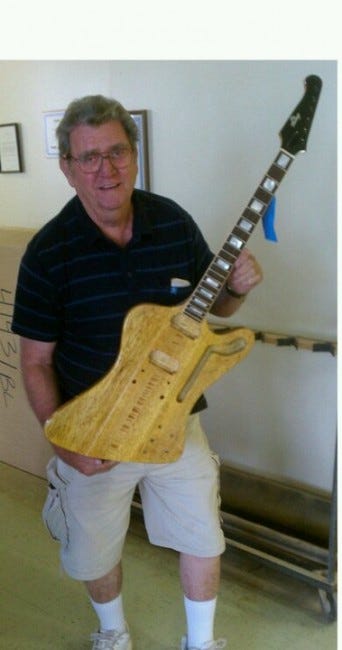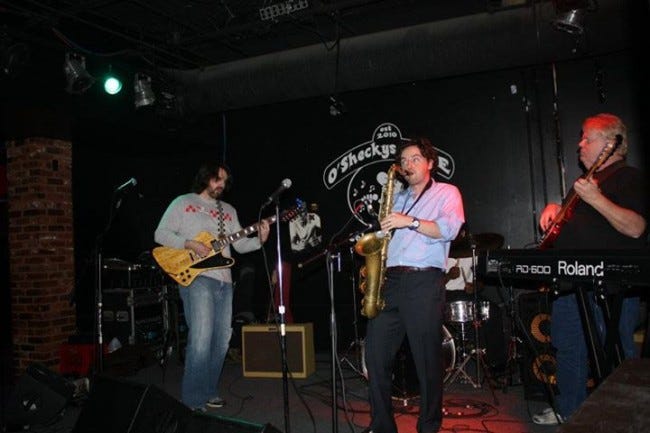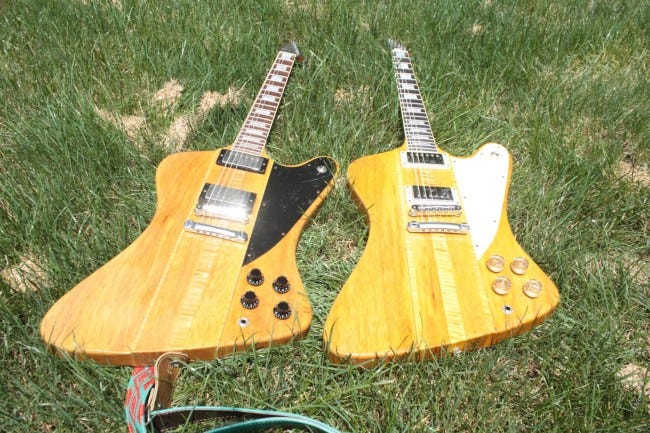Let The Record Show: I Briefly Owned Three Marvbirds

Okay, class, everyone who is not interested in the history of musical instruments, more particularly ones made by veterans of the Gibson factory in Kalamazoo, MI, is free to go out for recess. The rest of you can stick around to find out why a "Marvbird" is arguably the most historically important new guitar of this decade, why I bought three of them, and why I'll be down to two very shortly.

Marvin Lamb started working at Gibson in 1958. As in: nineteen fifty-eight. As in: he was there for all the greats. The "Burst" Les Paul as played by everyone from Clapton to (in replica form) Slash. The Flying V and Explorer. And the Firebird. All of them. He was in the factory when they were built. What part did he play in their construction? He barely remembers, although there is a photo of him that is ostensibly from 1956. (He says he started in 1958, but others disagree.)

Regardless, he is one of the last living people to remember and understand how Gibson built those incomparable Fifties and early Sixties guitars. When Gibson left Kalamazoo to focus on the Nashville plant, Marv founded the Heritage Guitar Company with three other former Gibson employees, including Jim Deurloo who was the shop foreman at the time Gibson left. They stayed in the basement of the old Kalamazoo plant and continued to make guitars the old-fashioned way using the tools that Gibson didn't think were worth taking along, along with fifteen or twenty employees. Most of their output goes overseas; the Japanese are particularly fond of Heritages and consider them the "real Gibsons".
My fondness for Heritage guitars is well-documented and at times I've owned as many as twenty-three of them, including three full hollowbodies. With that said, every Heritage guitar is a collaborative effort among the entire staff.
Except for the Marvbirds.
The Heritage H-357 was a regular-production model in the Nineties and used the same body shape as the neck-through Gibson Firebird. My friend Chris has a well-used Nineties H-357 and it plays brilliantly. The primary differences between the H-357 and the Firebird are the headstock (Gibson uses a beveled "birds-head") and the pickups (the Firebird originally used the mini-humbuckers that were left over from Gibson's acquisition of Epiphone, while the H-357 uses a conventional humbucker). It wasn't popular enough to remain in the lineup. This makes sense, as the Firebirds can be an acquired taste and you have to be physically large to play them comfortably.
Four or five years ago, Marv Lamb announced that he would be building H-357s again as a sort of hobby, doing just a few every year and taking payment directly for them. Several people claim to be responsible for Marv's decision to do this. Having met Marv twice and spoken to him several times via phone, my opinion is that he did what he wanted to do and heeded no one's counsel. Regardless, when I heard such a thing was available, I promptly signed up for it. In May of 2011, my son and his mother went to the Heritage factory in Kalamazoo and picked up my guitar for me:

It required some inspection.

John became very fond of the "Marvbird":

I ended up playing it that year during a rather odd Christmas party gig in the middle of rural Ohio:

It's a brilliant-sounding guitar that plays very easily once you get used to the idea that it hangs differently on your body than pretty much any other guitar would. Later that year, Jay Wolfe of Wolfe Guitars told me that Marv was going to build a few out of my favorite wood, Korina. I signed up for one and probably got the second or possibly third Korina Marvbird.
This time I plumped for Throbak pickups, so including the upcharge for the special wood this was an expensive guitar. That didn't stop me from playing it out and dinging it up a bit:

Earlier this year, Marv decided that his hands hurt too badly for him to continue building guitars individually, even at the pace of four a year. Two of my friends have Marvbirds as well, and I've seen maybe a total of six of them in real life. And that's where the story would end, except for the fact that two weeks ago I heard about another Korina H-357 for sale. This one was the "brother" of mine, being completed at the same time. While various people dithered and bickered and lowballed, I emptied out my bank account and drove the nine hour round-trip that night to take possession of it. You can see it here, together with the one I had before. The new one has the cream pickguard:

I like the wood a bit better on my new acquisition but prefer the finish on my old one.
And that is where the story would end, except for the fact that my ability to immediately buy the aforementioned third Marvbird without negotiation or delay ruffled some feathers among the owners' club. There's been a variety of complaining and personality conflict involved. Normally, I care not a whit about things like this, but after playing this new Marvbird back-to-back with my others I decided I liked it least of the three. So I listed it for sale and took three calls that same morning from serious buyers. It was an easy sale, although the owner isn't picking it up for two weeks.
Have to say, I'm still a little troubled by my decision to sell it. Yes, I already had two of them. However, these guitars are the most direct link to the magical Gibson era of 1959 short of buying a 1959 Les Paul at the low, low price of $250,000 for a beater with worn frets. I wonder if they'll be obscenely valuable to future generations. Hell, even a 1968 Les Paul Deluxe with the right specs can fetch $30,000 now. Have I just given up that kind of appreciation?
And just to confuse matters, I've just been told that Marv might consider building one or two more. Would he do one to my desired specs, which means some sort of translucent green finish and an ornate fretboard? Or would this be another take-it-as-it-comes deal? Should I put up a deposit?
The decision might be made for me by external factors. Starting early next month, there will be a lot less room in my house for guitars. But that's a story for another time.

